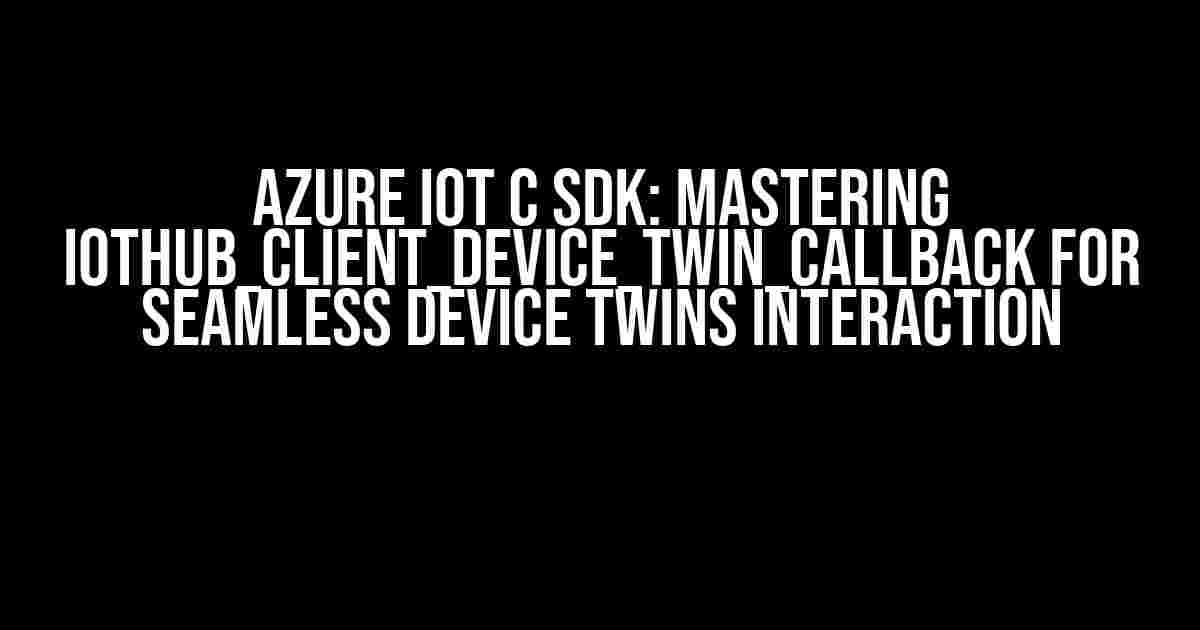Are you struggling to grasp the concept of IOTHUB_CLIENT_DEVICE_TWIN_CALLBACK in the Azure IoT C SDK? Look no further! This comprehensive guide will walk you through the intricacies of this crucial callback function, empowering you to harness the full potential of device twins in your IoT applications.
What is IOTHUB_CLIENT_DEVICE_TWIN_CALLBACK?
IOTHUB_CLIENT_DEVICE_TWIN_CALLBACK is a callback function in the Azure IoT C SDK that enables your device to receive notifications when its device twin is updated. A device twin is a digital representation of a physical device, storing its properties, configuration, and state. This callback function plays a vital role in keeping your device and its twin in sync, allowing for efficient and real-time communication.
Why Do I Need IOTHUB_CLIENT_DEVICE_TWIN_CALLBACK?
Implementing IOTHUB_CLIENT_DEVICE_TWIN_CALLBACK in your Azure IoT C SDK application offers several benefits:
- Real-time updates: Receive instant notifications when the device twin is updated, ensuring your device is always in sync.
- Efficient communication: Reduce the need for frequent polling, resulting in lower network traffic and improved performance.
- Improved reliability: Ensure your device is always aware of its current configuration and state, reducing errors and misconfigurations.
How to Implement IOTHUB_CLIENT_DEVICE_TWIN_CALLBACK
To get started with IOTHUB_CLIENT_DEVICE_TWIN_CALLBACK, follow these step-by-step instructions:
-
Include the necessary header files:
#include <azure/iot/iotc.h> #include <azure/iot/iotc_pal.h> -
Create an IoT Hub client and connect to the IoT Hub:
IOTHUB_CLIENT_LL_HANDLE iotHubClientHandle = IoTHubClient_LL_CreateFromConnectionString(connectionString, NULL); IoTHubClient_LL_SetOption(iotHubClientHandle, "ModelId", "your_model_id"); IoTHubClient_LL_SetMessageCallback(iotHubClientHandle, ReceiveMessageCallback, NULL); IoTHubClient_LL_SetDeviceMethodCallback(iotHubClientHandle, DeviceMethodCallback, NULL); IoTHubClient_LL_SetDeviceTwinCallback(iotHubClientHandle, DeviceTwinCallback, NULL); -
Define the IOTHUB_CLIENT_DEVICE_TWIN_CALLBACK function:
static void DeviceTwinCallback(IOTHUB_CLIENT_DEVICE_TWIN_INFO *deviceTwinInfo, void *userContextCallback) { if (deviceTwinInfo != NULL) { // Process the updated device twin properties printf("Received device twin update:\n"); printf(" Model Id: %s\n", deviceTwinInfo->modelId); printf(" Device Id: %s\n", deviceTwinInfo->deviceId); printf(" Properties: %s\n", deviceTwinInfo->properties); } else { printf("Error: Device twin update failed\n"); } }
Understanding IOTHUB_CLIENT_DEVICE_TWIN_INFO
The IOTHUB_CLIENT_DEVICE_TWIN_INFO structure contains essential information about the device twin update:
| Member | Description |
|---|---|
| modelId | The model ID associated with the device twin |
| deviceId | The device ID associated with the device twin |
| properties | A JSON string representing the updated device twin properties |
Best Practices for IOTHUB_CLIENT_DEVICE_TWIN_CALLBACK
-
Handle updates asynchronously: Process device twin updates in a separate thread to avoid blocking your main application thread.
-
Use retries and timeouts: Implement retry logic to handle cases where the device twin update fails, and set timeouts to avoid infinite loops.
-
Validate device twin updates: Verify the integrity and validity of the received device twin updates to prevent errors and misconfigurations.
Common Issues and Troubleshooting
Encountering issues with IOTHUB_CLIENT_DEVICE_TWIN_CALLBACK? Check out these common problems and solutions:
-
Device twin updates not received:
- Verify the device is connected to the IoT Hub.
- Check the device twin update frequency and adjust as necessary.
-
Device twin update processing fails:
- Verify the JSON parsing and processing logic.
- Check for memory leaks and buffer overflows.
-
Device twin updates are delayed or lost:
- Verify the network connectivity and IoT Hub connection.
- Check the device twin update queue size and adjust as necessary.
Conclusion
In conclusion, IOTHUB_CLIENT_DEVICE_TWIN_CALLBACK is a powerful feature in the Azure IoT C SDK that enables efficient and real-time communication between your device and its twin. By following the instructions and best practices outlined in this article, you’ll be well on your way to mastering device twins interaction and unlocking the full potential of your IoT applications.
Remember to stay tuned for more in-depth guides and tutorials on Azure IoT C SDK, and don’t hesitate to reach out if you have any further questions or concerns!
Frequently Asked Question
Get the inside scoop on Azure IoT C SDK’s IOTHUB_CLIENT_DEVICE_TWIN_CALLBACK and take your IoT development to the next level!
What is IOTHUB_CLIENT_DEVICE_TWIN_CALLBACK in Azure IoT C SDK?
IOTHUB_CLIENT_DEVICE_TWIN_CALLBACK is a callback function in the Azure IoT C SDK that allows you to receive notifications when your device’s twin properties are updated. It’s like having a personal assistant that keeps you in the loop about changes to your device’s configuration!
How does IOTHUB_CLIENT_DEVICE_TWIN_CALLBACK work in Azure IoT C SDK?
When you register IOTHUB_CLIENT_DEVICE_TWIN_CALLBACK, the Azure IoT Hub notifies your device whenever there’s a change to its device twin properties. The callback function is then triggered, giving you the opportunity to take action or update your device’s state accordingly. It’s like having a direct line to the Azure IoT Hub!
Why is IOTHUB_CLIENT_DEVICE_TWIN_CALLBACK important in Azure IoT C SDK?
IOTHUB_CLIENT_DEVICE_TWIN_CALLBACK is crucial because it enables your device to respond to changes in its configuration or state in real-time. This ensures that your device stays synchronized with the Azure IoT Hub, which is essential for reliable and efficient IoT operations. Think of it as keeping your device in perfect harmony with the cloud!
How do I implement IOTHUB_CLIENT_DEVICE_TWIN_CALLBACK in my Azure IoT C SDK project?
To implement IOTHUB_CLIENT_DEVICE_TWIN_CALLBACK, you need to define a callback function and register it with the IoTHubClient_LL_CreateFromDevice method. Then, in your callback function, you can process the device twin updates and take necessary actions. It’s like following a recipe to IoT success!
What are some common use cases for IOTHUB_CLIENT_DEVICE_TWIN_CALLBACK in Azure IoT C SDK?
IOTHUB_CLIENT_DEVICE_TWIN_CALLBACK is perfect for scenarios like remote firmware updates, configuration changes, or monitoring device health. It’s also useful for implementing device-specific logic or integrating with other services. The possibilities are endless, and it’s like having a superpower in your IoT toolkit!
